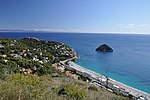Nemo's Garden is an underwater cultivation designed by Sergio Gamberini along with a team from Ocean Reef Group in 2012, and currently coordinated by Gianni Fontanesi. The project was born to face main global issues, such as: climate change, pollution, malnourishment and hunger. It actively operates, and is open to visitors, from late June until late September.
The garden is located in Noli, Italy, and it consists in an underwater installation of several vinyl-plastic biospheres containing various kinds of herbs, vegetables and flowers that are being tested and observed for this alternative and sustainable way of gardening.
This concept of underwater agriculture exploits the sea, and the possibilities it offers, as its primary resource. It aims to be adaptable to the most hostile places on earth, where the lack of agricultural means causes poverty and hunger, and repopulate the reef in areas where pollution has destroyed it.
Nemo's Garden has the main goal of not harming the planet, consequently it was designed to be: self-sustainable, using mainly renewable energy from natural resources such as the sun and having the ability of reutilizing the freshwater it produces, eco-friendly, not harming the surrounding environment and its natural marine ecosystem that is heterogeneous, has an oligotrophic nature, a high diversity in marine species, and a high rate of endemism, and ecological, not producing any pollution.
The project is divided into two phases: the one going from 2012 until 2016, called "the 2016 phase", and the one being observed now. During the 2016 phase the objectives were: collecting data from the plants and analyzing their characteristics, designing and making the hydroponic system work, and taking into consideration the possibility of using the garden in cosmetic, pharmaceutical, and nutraceutical applications.











